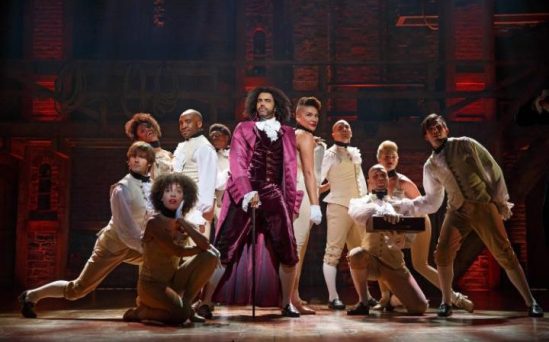The modern world has produced two hugely popular ‘musicals’ that have a distinct operatic structure yet are referred to as musicals. Les Misearables and The Phantom of the Opera may not be treated as operas but they are essentially contemporary takes on the operatic tradition of presenting a whole narrative solely through music. American Broadway hit Hamilton is the most recent addition to this tradition, with one huge artistic difference; It has absolutely no regard for musical genre.
The musical, created by Lin-Manuel Miranda, follows the life of American founding father Alexander Hamilton. There are three distinct plot strands: Hamilton’s career, from penniless rebel soldier to high-ranking politician and the mistakes that led to his downfall. Hamilton’s relationship with fellow politician Aaron Burr, which goes from friendship to rivalry to enmity and culminates in a duel to the death. And in the background, America’s War of Independence and the aftermath as a new country struggles to find its feet.
The boldness of Lin-Manuel Miranda’s approach is honestly admirable; rather than focus on musical form, he simply takes people and concepts from another time and makes them as immediate as possible, grabbing indiscriminately from whatever musical genre seems appropriate. While the predominant style is Hip-Hop and R&B, the music always serves the story rather than the other way around. Hamilton’s personality is established in his number ‘My shot’:
“I am not throwing away my shot!
I am not throwing away my shot!
Hey yo, I’m just like my country
I’m young, scrappy and hungry
And I’m not throwing away my shot!”
All of the protagonist’s personality is right there for the audience: he is energetic, direct, determined, unpolished, patriotic, charismatic and ambitious. The effect of the musical approach is to translate into modern terms something that would otherwise be very much rooted in historical context. Miranda has no interest in a historically accurate recreation of the period. His interest is in translating history into terms that the audience can engage with. His portrayal of Thomas Jefferson is a perfect example of this: in the immediate aftermath of the war, Jefferson returns to America after years in France. He has picked up French attitudes and mannerisms, making him slightly unpopular. This aspect of characterisation is rather historically specific. Miranda’s solution is to give Jefferson a distinctive Southern Jazz number that is utterly divorced from everyone else’s musical style. Some of his lines also have a dated, slightly effete feel to them:
“Virginia, my home sweet home, I wanna give you a kiss. Mwah!”
Jefferson’s character seems foreign and rather bemusing compared to Hamilton.
 Daveed Diggs as Thomas Jefferson. Source: Telegraph.co.uk
Daveed Diggs as Thomas Jefferson. Source: Telegraph.co.uk
The portrayal of George III is the high point of this practice of using lyrics and musical genre to tell the story. King George treats America like an estranged lover he is trying to win back…by violence if necessary.
“You’ll be back, like before
I will fight the fight and win the war
For your love, for your praise
And I’ll love you till my dying days!
When you’re gone, I’ll go mad
So don’t throw away this thing we had
Coz when push comes to shove
I will kill your friends and family to remind you of my love!”
This is an extension of the technique elsewhere; sacrificing realism in favour of loose translation for immediate effect. The result is a fairly accurate (and funny) take on U.S.-British relations when America was seeking independence. The music again serves the story: King George is given a smooth, carefree tune vaguely reminiscent of 1940s Brit Pop. It is an oddly bland and safe-feeling number, utterly dissimilar to other characters music. This serves to illustrate how formal and practiced a Kings writing style would have been and the cultural divide between America and the ruling power.
Overall, the structural approach Hamilton takes to its subject matter is perfectly artificial, but translates its narrative in some ways more directly than a naturalistic approach.
